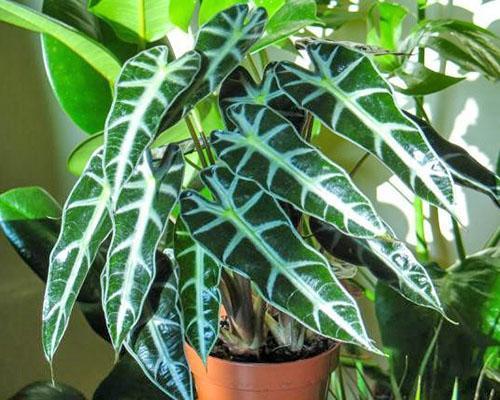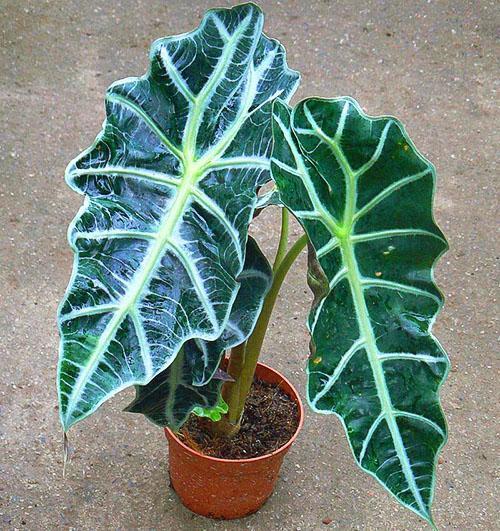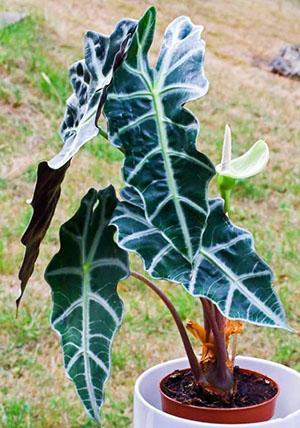Meet alocasia amazonian - the most common large-leaved domestic plant
 The alocasia amazonian aroid flower is a hybrid of the Lowe and Sandera species, and is often sold as Sandera. It attracts flower growers with decorative leaves that grow even in captivity up to half a meter in length. A small stem, up to 15 cm, makes the bush compact and decorative. The difference between the Amazon is the color of the leaf cuttings, it is pink. Like all other types of alocasia, Australian is poisonous, but it is not used for treatment. Amongbegonias, violets, spathiphyllums, anthuriums, hippeastrum, pelargonium and other plants, alocasia stands out for its beautiful foliage and neat shape.
The alocasia amazonian aroid flower is a hybrid of the Lowe and Sandera species, and is often sold as Sandera. It attracts flower growers with decorative leaves that grow even in captivity up to half a meter in length. A small stem, up to 15 cm, makes the bush compact and decorative. The difference between the Amazon is the color of the leaf cuttings, it is pink. Like all other types of alocasia, Australian is poisonous, but it is not used for treatment. Amongbegonias, violets, spathiphyllums, anthuriums, hippeastrum, pelargonium and other plants, alocasia stands out for its beautiful foliage and neat shape.
Maintenance and care requirement

 As a result of flowering of Amazonian alocasia, red berries ripen in nature. Inside the pulp are seeds that are ready to germinate. The berry that does not have time to dry is sown, and a sprout will appear in a month. Other methods of reproduction are the use of babies, cuttings from the stem bud and leaf.
As a result of flowering of Amazonian alocasia, red berries ripen in nature. Inside the pulp are seeds that are ready to germinate. The berry that does not have time to dry is sown, and a sprout will appear in a month. Other methods of reproduction are the use of babies, cuttings from the stem bud and leaf.
Caring for alocasia at home is to fulfill the requirements that are individual for each type of houseplants:
- place of detention;
- temperature regime and air humidity;
- watering and feeding;
- soil requirements and transplant times;
- pest and disease control.
Due to the fact that all parts of the plant are poisonous, care for it must be carried out with gloves and the container must be installed out of the reach of children and animals.
 Usually the plant is installed in a bright room with diffused sunlight. Direct rays burn the leaves, depriving them of their decorative effect. Alocasia window is uncomfortable in close quarters among other inhabitants. Therefore, a stand is made for her not far from the light source. In office spaces, the plant is loved for its large, spreading leaves.
Usually the plant is installed in a bright room with diffused sunlight. Direct rays burn the leaves, depriving them of their decorative effect. Alocasia window is uncomfortable in close quarters among other inhabitants. Therefore, a stand is made for her not far from the light source. In office spaces, the plant is loved for its large, spreading leaves.
At home, the best place for alocasia is the kitchen or bathroom. The plant feels great at a humidity of 80% and a temperature in summer 21 - 27 0, in winter the temperature can be lowered to 18. To create a comfortable zone in a dry room, the alocasia pot can be placed on a pallet with moss or expanded clay so that there is evaporation. Moisture is created by a fine spray from a spray bottle over the plant, by frequent wiping the leaves with a damp sponge.
Watering alocasia loves moderate, but without drying out the clod of the earth. A slightly drooping leaf blade will signal a lack of water. In the summer, watering with settled soft water is required every other day, in winter once a week, while the ground should dry out on top. If watering is carried out by bottom method, then after an hour the rest of the water is drained from the pan. The roots love moist soil saturated with oxygen.
 Light, loose and slightly acidic composition based on peat and the leafy earth must be saturated with air.Therefore, chopped sphagnum moss, crushed porous charcoal and sand are added to the composition. It will be useful to mix in red brick chips and vermiculite. Each of the minerals releases elements in the form of dissolved salts, which feed the plant.
Light, loose and slightly acidic composition based on peat and the leafy earth must be saturated with air.Therefore, chopped sphagnum moss, crushed porous charcoal and sand are added to the composition. It will be useful to mix in red brick chips and vermiculite. Each of the minerals releases elements in the form of dissolved salts, which feed the plant.
 During the growing season, the plant needs to be fed every three weeks with special fertilizers based on nitrogen and potassium. In winter, feeding is cut in half. Phosphorus salts in the form of soluble monophosphates should be added for young plants.
During the growing season, the plant needs to be fed every three weeks with special fertilizers based on nitrogen and potassium. In winter, feeding is cut in half. Phosphorus salts in the form of soluble monophosphates should be added for young plants.
The Amazonian alocasia does not like drafts. Therefore, it must be installed in a place deaf to air flows. The plant itself absorbs harmful substances from the air, recycles them, destroys unpleasant odors and air pollution from industrial emissions.
Diseases and pests of alocasia amazon
 When a plant is well cared for, it is protected from disease. But with dry air, rare treatment under the shower, pests can appear on the plant:
When a plant is well cared for, it is protected from disease. But with dry air, rare treatment under the shower, pests can appear on the plant:
- spider mite;
- shield;
- aphid.
To combat them, soap and tobacco solutions, alcohol rubdown for scabbards and biological preparations are used. If there are many pests, insecticides are used - Fitoverm, Aktara, Ikonfidor.
It is not superfluous to keep the newly acquired plant specimen in quarantine for at least 2 weeks for the prevention of Amazonian alocasia diseases. Diseases and pests during this time will appear, and other plants will be protected from infection.
 Improper watering of alocasia can lead to decay of roots and leaves. But it is a non-communicable disease affecting one plant. If the maintenance of tropical plants is carried out in a cold damp corner, then the diseases of Amazonian alocasia are associated with the settlement of spores and the growth of the mycelium phytophthora or powdery mildew. Spores slumber in the soil for the time being, introduced with untreated soil during transplantation. In this case, only fungicides will help you not to lose the green garden at home.
Improper watering of alocasia can lead to decay of roots and leaves. But it is a non-communicable disease affecting one plant. If the maintenance of tropical plants is carried out in a cold damp corner, then the diseases of Amazonian alocasia are associated with the settlement of spores and the growth of the mycelium phytophthora or powdery mildew. Spores slumber in the soil for the time being, introduced with untreated soil during transplantation. In this case, only fungicides will help you not to lose the green garden at home.